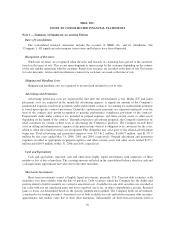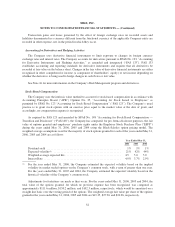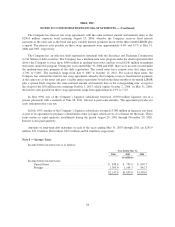Nike 2006 Annual Report Download - page 52
Download and view the complete annual report
Please find page 52 of the 2006 Nike annual report below. You can navigate through the pages in the report by either clicking on the pages listed below, or by using the keyword search tool below to find specific information within the annual report.NIKE, INC.
NOTES TO CONSOLIDATED FINANCIAL STATEMENTS — (Continued)
May 31, 2006 have remaining maturities of 180 days or less. Included in interest (income) expense, net for the
years ended May 31, 2006, 2005, and 2004, was interest income of $87.3 million, $34.9 million and $15.3
million, respectively, related to short-term investments and cash and cash equivalents.
Inventory Valuation
Inventories are stated at the lower of cost or market. Inventories are valued on a first-in, first-out (“FIFO”)
or moving-average cost basis.
Property, Plant and Equipment and Depreciation
Property, plant and equipment are recorded at cost. Depreciation for financial reporting purposes is
determined on a straight-line basis for buildings and leasehold improvements over 2 to 40 years and principally
on a double declining balance basis for machinery and equipment over 2 to 15 years. Computer software
(including, in some cases, the cost of internal labor) is depreciated on a straight-line basis over 3 to 10 years.
Impairment of Long-Lived Assets
In accordance with Statement of Financial Accounting Standards (“SFAS”) No. 144 “Accounting for the
Impairment or Disposal of Long-Lived Assets” (“FAS 144”), the Company estimates the future undiscounted
cash flows to be derived from an asset to assess whether or not a potential impairment exists when events or
circumstances indicate the carrying value of a long-lived asset may be impaired. If the carrying value exceeds the
Company’s estimate of future undiscounted cash flows, the Company then calculates the impairment as the
excess of the carrying value of the asset over the Company’s estimate of its fair market value.
Identifiable Intangible Assets and Goodwill
In accordance with SFAS No. 142 “Goodwill and Other Intangible Assets” (“FAS 142”), goodwill and
intangible assets with indefinite lives are not amortized but instead are measured for impairment at least annually
in the fourth quarter, or when events indicate that an impairment exists. As required by FAS 142, in the
Company’s impairment test of goodwill, the Company compares the fair value of the applicable reporting unit to
its carrying value. The Company estimates the fair value of its reporting units by using a combination of
discounted cash flow analysis and comparisons with the market values of similar publicly traded companies. If
the carrying value of the reporting unit exceeds the estimate of fair value, the Company calculates the impairment
as the excess of the carrying value of goodwill over its implied fair value. In the impairment tests for indefinite-
lived intangible assets, the Company compares the estimated fair value of the indefinite-lived intangible assets to
the carrying value. The Company estimates the fair value of indefinite-lived intangible assets, trademarks, using
the relief from royalty approach, which is a standard form of discounted cash flow analysis typically used for the
valuation of trademarks. If the carrying value exceeds the estimate of fair value, the Company calculates
impairment as the excess of the carrying value over the estimate of fair value.
Intangible assets that are determined to have definite lives are amortized over their useful lives and are
measured for impairment only when events or circumstances indicate the carrying value may be impaired in
accordance with FAS 144 discussed above.
Foreign Currency Translation and Foreign Currency Transactions
Adjustments resulting from translating foreign functional currency financial statements into U.S. dollars are
included in the foreign currency translation adjustment, a component of accumulated other comprehensive
income in shareholders’ equity.
51
























